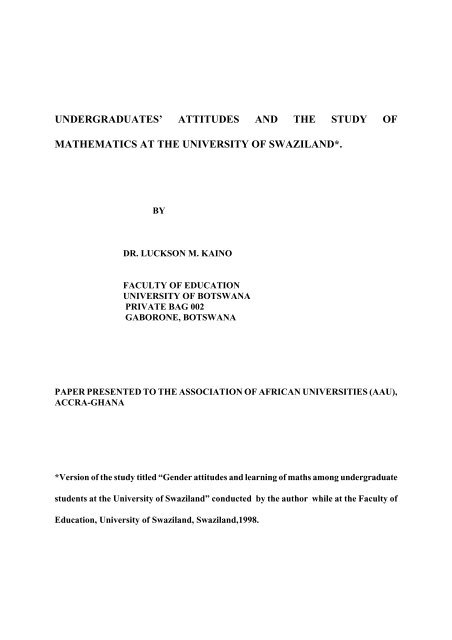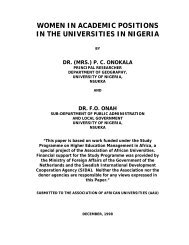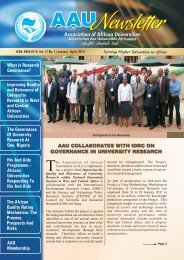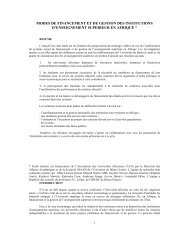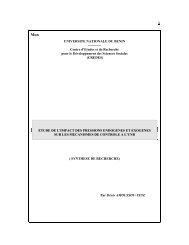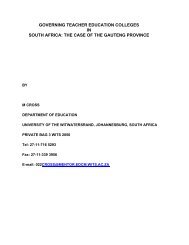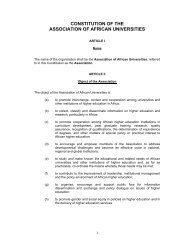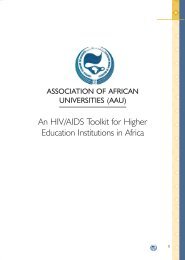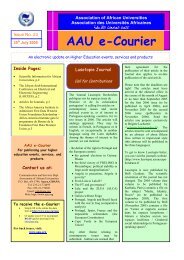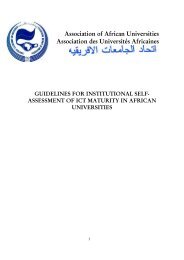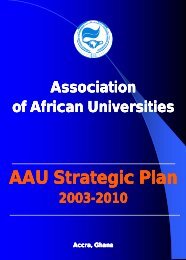undergraduates' attitudes and the study of mathematics at the ...
undergraduates' attitudes and the study of mathematics at the ...
undergraduates' attitudes and the study of mathematics at the ...
- No tags were found...
You also want an ePaper? Increase the reach of your titles
YUMPU automatically turns print PDFs into web optimized ePapers that Google loves.
UNDERGRADUATES’ ATTITUDES AND THE STUDY OF<br />
MATHEMATICS AT THE UNIVERSITY OF SWAZILAND*.<br />
BY<br />
DR. LUCKSON M. KAINO<br />
FACULTY OF EDUCATION<br />
UNIVERSITY OF BOTSWANA<br />
PRIVATE BAG 002<br />
GABORONE, BOTSWANA<br />
PAPER PRESENTED TO THE ASSOCIATION OF AFRICAN UNIVERSITIES (AAU),<br />
ACCRA-GHANA<br />
*Version <strong>of</strong> <strong>the</strong> <strong>study</strong> titled “Gender <strong><strong>at</strong>titudes</strong> <strong>and</strong> learning <strong>of</strong> m<strong>at</strong>hs among undergradu<strong>at</strong>e<br />
students <strong>at</strong> <strong>the</strong> University <strong>of</strong> Swazil<strong>and</strong>” conducted by <strong>the</strong> author while <strong>at</strong> <strong>the</strong> Faculty <strong>of</strong><br />
Educ<strong>at</strong>ion, University <strong>of</strong> Swazil<strong>and</strong>, Swazil<strong>and</strong>,1998.
‣ Abstract<br />
‣ The paper analyses undergradu<strong>at</strong>e <strong><strong>at</strong>titudes</strong> <strong>and</strong> <strong>the</strong> <strong>study</strong> <strong>of</strong> ma<strong>the</strong>m<strong>at</strong>ics <strong>at</strong> <strong>the</strong> University <strong>of</strong><br />
Swazil<strong>and</strong>. It involves performance, enrolment <strong>and</strong> dropout in ma<strong>the</strong>m<strong>at</strong>ics;<br />
interest,confidence <strong>and</strong> influencing factors to <strong>study</strong> <strong>the</strong> subject. The sample involves B.Sc<br />
<strong>and</strong> B.Ed students,<strong>and</strong> University lecturers. A survey <strong>of</strong> liter<strong>at</strong>ure on gender studies in Sub-<br />
Saharan African countries is presented <strong>and</strong> particular <strong>at</strong>tention is paid to gender studies on<br />
ma<strong>the</strong>m<strong>at</strong>ics done in <strong>the</strong> region <strong>and</strong> elsewhere. It is concluded th<strong>at</strong> <strong>the</strong> teaching <strong>of</strong> <strong>the</strong> subject<br />
should reflect <strong>the</strong> significance <strong>of</strong> <strong>the</strong> subject involving students’ future careers. The subject<br />
should be taught with an applic<strong>at</strong>ion approach to arose interest among students; <strong>the</strong> curricula<br />
as well as teaching <strong>of</strong> <strong>the</strong> subject are also to be gender sensitive. At <strong>the</strong> end, some<br />
recommend<strong>at</strong>ions are suggested.<br />
2
INTRODUCTION<br />
Studies on gender disparities have been done in both developed <strong>and</strong> developing countries. In<br />
<strong>the</strong>se countries women in institutions <strong>of</strong> higher learning tend to concetr<strong>at</strong>e in certain fields <strong>of</strong><br />
<strong>study</strong> such as humanities, home economics <strong>and</strong> arts, though more women have now enrolled in<br />
o<strong>the</strong>r fields like business <strong>and</strong> public administr<strong>at</strong>ion. The enrolment in <strong>the</strong> fields such as m<strong>at</strong>hs<br />
<strong>and</strong> science rel<strong>at</strong>ed fields is however still limited. Low enrollment in m<strong>at</strong>hs <strong>and</strong> science fields<br />
can be said to result from a number <strong>of</strong> factors affecting women especially <strong>at</strong> different levels <strong>of</strong><br />
schooling. For example traditional <strong>and</strong> cultural expect<strong>at</strong>ions from different societies in <strong>the</strong><br />
developing world in particular, seem to have an influence on subject choice <strong>and</strong> selection<br />
especially <strong>at</strong> secondary school level.<br />
In developed countries,where many studies on gender differences in m<strong>at</strong>hs have been done, some<br />
different views have emerged whe<strong>the</strong>r <strong>the</strong> differences were declining in those countries or not.<br />
Also some studies in both developed <strong>and</strong> developing countries have indic<strong>at</strong>ed th<strong>at</strong> gender<br />
differences in m<strong>at</strong>hs performance existed in upper grades <strong>and</strong> th<strong>at</strong> <strong>the</strong>y were not significant in<br />
lower grades. The premise put forward is th<strong>at</strong> gender differences could increase as students go to<br />
higher levels <strong>of</strong> schooling. This article reviews such a trend with d<strong>at</strong>a involving performance,<br />
<strong><strong>at</strong>titudes</strong>, enrolment <strong>and</strong> dropout in <strong>the</strong> subject<br />
Gender studies in Sub-Saharan Africa<br />
Gender disparities in educ<strong>at</strong>ion in developing countries can be said to be characterised by some<br />
influences from cultural <strong>and</strong> traditional practices. In Sub-Saharan Africa, educ<strong>at</strong>ion has been<br />
influenced by for example indigenous cultures, religion <strong>and</strong> educ<strong>at</strong>ion provided in <strong>the</strong> western<br />
3
culture style since 1960s most when African countries became independent. Although many<br />
countries made efforts in educ<strong>at</strong>ion females <strong>and</strong> males in <strong>the</strong>se countries were not equally<br />
educ<strong>at</strong>ed. The inequality in educ<strong>at</strong>ion is reflected in lower enrolment r<strong>at</strong>es, higher dropout r<strong>at</strong>es<br />
<strong>and</strong> lower performances among girls in schools. Inequality is also found in curricular choices<br />
<strong>of</strong>fered <strong>at</strong> secondary <strong>and</strong> tertiary levels where for example low enrolment r<strong>at</strong>es affected women<br />
in science, m<strong>at</strong>hs <strong>and</strong> technical fields in general.<br />
Some studies have indic<strong>at</strong>ed th<strong>at</strong> <strong>the</strong> n<strong>at</strong>ure <strong>of</strong> schooling from <strong>the</strong> earliest years on, could shape<br />
<strong>the</strong> capacities <strong>and</strong> strengths <strong>of</strong> <strong>the</strong> growing female (Maccia et al 1975). This implies th<strong>at</strong> if we<br />
have to look <strong>at</strong> <strong>the</strong> <strong>study</strong> <strong>of</strong> females <strong>at</strong> higher educ<strong>at</strong>ion e.g. <strong>at</strong> University level, we have also to<br />
look into <strong>the</strong> schooling before entering university, by considering <strong>at</strong> <strong>the</strong>se schools as even small<br />
societies, <strong>the</strong> values <strong>the</strong>y represent, <strong>the</strong> form <strong>and</strong> content <strong>of</strong> learning <strong>of</strong>fered <strong>and</strong> <strong>the</strong> type <strong>of</strong><br />
educ<strong>at</strong>ional environment which existed.<br />
Some research findings on <strong>the</strong> rel<strong>at</strong>ionship between gender <strong>and</strong> achievement has shown some<br />
mixed results. For example, <strong>the</strong> <strong>study</strong> by Heyneman (1975) showed th<strong>at</strong> gender was <strong>the</strong> most<br />
single important variable in explaining differences in achievement in Ug<strong>and</strong>an schools where<br />
boys performed better than girls. Using a n<strong>at</strong>ional sample <strong>of</strong> secondary school leavers in<br />
Tanzania, Amuge (1987) found th<strong>at</strong> boys outperformed girls in secondary schools in almost<br />
every subject except commerce. The <strong>study</strong> done in Mauritius by Chinapah (1983) found th<strong>at</strong> girls<br />
outperformed boys in both urban <strong>and</strong> rural areas. Ano<strong>the</strong>r <strong>study</strong> done in Kenya by Boit (1986)<br />
found th<strong>at</strong> girls in government <strong>and</strong> government aided secondary schools performed as well as<br />
boys, <strong>and</strong> pupils in single-sex schools performed better than those in mixed schools.<br />
4
Some studies have shown th<strong>at</strong> girls in single-sex schools performed better than girls in mixed<br />
schools in Nigerian <strong>and</strong> Swazil<strong>and</strong> schools (Lockhead <strong>and</strong> Komenan, 1988; Kaino, 1996).<br />
Though many studies did not investig<strong>at</strong>e factors which affected girls performance in class,<br />
factors such as family influences, traditional <strong>and</strong> school characteristics had a role to play in<br />
influencing girls performance. For example girls had less time to <strong>study</strong> as <strong>the</strong>y were burdened<br />
with household tasks <strong>at</strong> home (than boys) <strong>and</strong> this was likely to lower <strong>the</strong>ir achievement<br />
(Fapohunda 1978, Wrzesinska 1980, <strong>and</strong> Wheldon <strong>and</strong> Smith 1986). School characteristics could<br />
involve for example <strong>the</strong> type <strong>of</strong> school (girls, boys or mixed), sex <strong>of</strong> teachers <strong>and</strong> <strong>the</strong> <strong><strong>at</strong>titudes</strong> <strong>of</strong><br />
both students as well as teachers in learning in <strong>the</strong> school environment. O<strong>the</strong>r school<br />
characteristics could be <strong>the</strong> situ<strong>at</strong>ion where teachers were less likely to encourage girls to pursue<br />
m<strong>at</strong>hs <strong>and</strong> science subjects (Eshiwani 1983) <strong>and</strong> girls' schools where girls were more confident<br />
with better performance than girls in mixed schools (Kaino, 1996).<br />
Gender studies in ma<strong>the</strong>m<strong>at</strong>ics<br />
Many studies on gender differences in <strong>the</strong> <strong>study</strong> <strong>of</strong> m<strong>at</strong>hs have been done in developed countries<br />
than in developing countries. While studies in developed countries have indic<strong>at</strong>ed th<strong>at</strong> gender<br />
differences in ma<strong>the</strong>m<strong>at</strong>ical performance were diminishing in <strong>the</strong>se countries, some o<strong>the</strong>r studies<br />
have come up with contradicting views. The <strong>study</strong> by Hyde et al (1990) showed th<strong>at</strong> for <strong>the</strong> past<br />
30 years gender differences in m<strong>at</strong>hs performance were diminishing in developed countries. This<br />
contention was supported by studies in Canada <strong>and</strong> United St<strong>at</strong>es by Lafortune (1989) <strong>and</strong> Frost<br />
et al (1994) respectively. While Lafortune showed th<strong>at</strong> girls <strong>and</strong> boys performed equally well in<br />
m<strong>at</strong>hs <strong>the</strong> <strong>study</strong> revealed th<strong>at</strong> girls had still some more neg<strong>at</strong>ive <strong>at</strong>titude towards m<strong>at</strong>hs due to<br />
<strong>the</strong>ir gre<strong>at</strong>er anxiety when learning m<strong>at</strong>hs.<br />
5
A recent <strong>study</strong> done in Germany by Kaiser-Messmer (1994) contradicts <strong>the</strong> views th<strong>at</strong><br />
gender differences in performance were diminishing. Kaiser-Massmer's <strong>study</strong> showed<br />
th<strong>at</strong> girls had significantly lower grades than boys in lower <strong>and</strong> upper secondary schools.<br />
Fur<strong>the</strong>rmore, about twice as many girls as boys expressed no interest in m<strong>at</strong>hs <strong>at</strong> lower<br />
secondary school level (11-15 year olds). At upper secondary school level (16-19 years)<br />
<strong>the</strong>re were no significant gender differences noted.<br />
The existence <strong>of</strong> gender differences as early as in <strong>the</strong> fifth grade (<strong>at</strong> about 9 years <strong>of</strong> age)<br />
<strong>and</strong> th<strong>at</strong> <strong>the</strong>y increased in higher grade was earlier noted by Winjstra (1988). This view<br />
was also supported by Ethington <strong>and</strong> Wolfe (1984), Johnson (1987), <strong>and</strong> Martin <strong>and</strong><br />
Hoover (1987) who concluded th<strong>at</strong> gender rel<strong>at</strong>ed differences in m<strong>at</strong>hs performance were<br />
more clearer in older students (in higher grades). The above views would imply th<strong>at</strong><br />
gender differences could exist beyond <strong>the</strong> high school level i.e. up to University level.<br />
Some studies have indic<strong>at</strong>ed th<strong>at</strong> socio-economic st<strong>at</strong>us <strong>of</strong> parents <strong>and</strong> family influences<br />
(Gilbert 1986) <strong>and</strong> belief in m<strong>at</strong>hs future usefulness, positive <strong><strong>at</strong>titudes</strong> towards m<strong>at</strong>hs <strong>and</strong><br />
socialising processes (Kaiser-Messmer, 1994) were significant factors in minimising<br />
gender differences in m<strong>at</strong>hs performance. Experiences <strong>of</strong> girls, for example in <strong>the</strong><br />
classroom learning environment has tended to influence neg<strong>at</strong>ive <strong><strong>at</strong>titudes</strong> towards <strong>the</strong><br />
<strong>study</strong> <strong>of</strong> m<strong>at</strong>hs. Situ<strong>at</strong>ions where for example teachers gave more <strong>at</strong>tention to boys than<br />
girls in class (Leder, 1987 & 1990; Becker, 1991), m<strong>at</strong>hs textbooks with gender bias<br />
(Scott, 1980) <strong>and</strong> teachers reluctance to encourage girls to <strong>study</strong> m<strong>at</strong>hs (Eshiwani, 1983)<br />
are among <strong>the</strong> factors considered to affect girls' <strong><strong>at</strong>titudes</strong> as well as <strong>the</strong>ir performance in<br />
m<strong>at</strong>hs.<br />
6
The findings th<strong>at</strong> girls were frightened <strong>of</strong> m<strong>at</strong>hs than boys (Tobias, 1978) <strong>and</strong> th<strong>at</strong> girls<br />
were unsure <strong>of</strong> <strong>the</strong>ir ma<strong>the</strong>m<strong>at</strong>ical ability (J<strong>of</strong>fe <strong>and</strong> Foxman, 1986) could be a result <strong>of</strong><br />
such influences through neg<strong>at</strong>ive practices in <strong>the</strong> classroom. A number <strong>of</strong> studies have<br />
shown th<strong>at</strong> boys' more interaction with teachers in class than girls tend to influence better<br />
development <strong>of</strong> ma<strong>the</strong>m<strong>at</strong>ical concepts among male students. Also <strong>the</strong> p<strong>at</strong>tern <strong>of</strong><br />
interaction in class tended to make boys appear more competent in m<strong>at</strong>hs than girls<br />
(Jungwirth, 1991). Boys gre<strong>at</strong>er use <strong>of</strong> verbal <strong>and</strong> non-verbal language to domin<strong>at</strong>e more<br />
<strong>of</strong> <strong>the</strong> teacher's time in terms <strong>of</strong> <strong>at</strong>tention <strong>and</strong> classroom control is one <strong>of</strong> <strong>the</strong> influencing<br />
factors favouring boys in class (Skelton, 1993). For example, boys <strong>at</strong>traction to <strong>the</strong><br />
teacher's time could be <strong>at</strong>tained by boys being more mobile than girls in <strong>the</strong> classroom<br />
(Serbin, 1978 <strong>and</strong> Lee, 1990).<br />
The belief to some people th<strong>at</strong> m<strong>at</strong>hs was a male domain Boswell (1985) was not only<br />
held by ordinary people in society e.g. those who were not in <strong>the</strong> field <strong>of</strong> m<strong>at</strong>hs, but also<br />
to m<strong>at</strong>hs teachers <strong>the</strong>mselves. Some m<strong>at</strong>hs teachers had a belief th<strong>at</strong> boys were more<br />
academically capable than girls <strong>and</strong> th<strong>at</strong> boys' m<strong>at</strong>hs contributions were more impressive<br />
(Fennema <strong>at</strong> el 1990 <strong>and</strong> Fennema, 1990). Though some girls' work could be identical to<br />
th<strong>at</strong> <strong>of</strong> boys, boys could still be r<strong>at</strong>ed higher than girls. The sex <strong>of</strong> <strong>the</strong> teacher could also<br />
be an influencing factor where for example <strong>the</strong> assessment <strong>of</strong> boys by a female teacher<br />
could produce a generous mark, whilst <strong>the</strong> most severe marking <strong>of</strong> girls' work by a male<br />
teacher (Goddar-Spear, 1989).<br />
As some studies have shown, girls in co-educ<strong>at</strong>ion schools had some neg<strong>at</strong>ive <strong>at</strong>titude<br />
7
towards m<strong>at</strong>hs <strong>and</strong> th<strong>at</strong> girls in single sex schools had a higher opinion <strong>of</strong> <strong>the</strong>ir<br />
ma<strong>the</strong>m<strong>at</strong>ical ability than girls in mixed schools (Gwizdala <strong>and</strong> Steinbach, 1990; Kaino,<br />
1996) was an indic<strong>at</strong>ion th<strong>at</strong> <strong>study</strong>ing in <strong>the</strong> co-educ<strong>at</strong>ion envirionment could be an<br />
influencing factor affecting girls performance. As Martin (1981) argues, <strong>the</strong> premise th<strong>at</strong><br />
<strong>the</strong> provision <strong>of</strong> <strong>the</strong> same learning m<strong>at</strong>erials e.g. books, labor<strong>at</strong>ory equipment, qualified<br />
teachers, etc. could produce female <strong>and</strong> male students with equal opportunities i.e.<br />
perform equally well, build up confidence <strong>and</strong> interest in m<strong>at</strong>hs, was not likely to be<br />
achieved if m<strong>at</strong>hs teachers were not sensitive to differences between boys <strong>and</strong> girls in coeduc<strong>at</strong>ion<br />
schools.<br />
The views provided in <strong>the</strong> above cited studies indic<strong>at</strong>e th<strong>at</strong> <strong>the</strong>re was still some mixed<br />
feelings on <strong>the</strong> magnitude <strong>of</strong> gender differences in m<strong>at</strong>hs <strong>at</strong> lower levels <strong>and</strong> <strong>the</strong> increase<br />
<strong>of</strong> gender differences <strong>at</strong> secondary <strong>and</strong> high schools. While <strong>the</strong>re was some more<br />
evidence th<strong>at</strong> gender differences were not significant in lower grades, many studies have<br />
shown th<strong>at</strong> gender differences existed in upper grades. Though studies on gender<br />
differences in m<strong>at</strong>hs were not many <strong>and</strong> much <strong>of</strong> <strong>the</strong> research has been done in developed<br />
countries, <strong>the</strong> few studies done in developing countries <strong>and</strong> in Sub-Saharan African<br />
region in particular showed almost similar results in m<strong>at</strong>hs gender differences done<br />
elsewhere. However, liter<strong>at</strong>ure on m<strong>at</strong>hs gender differences beyond high school level i.e.<br />
<strong>at</strong> University level is scanty.<br />
8
EMPIRICAL DATA AND ANALYSIS<br />
The enrolment <strong>of</strong> students by gender in various courses <strong>at</strong> <strong>the</strong> University <strong>of</strong> Swazil<strong>and</strong> for 12<br />
academic years (1982-1994), showed an increase <strong>of</strong> more than 100% (124%) in female<br />
enrollment compared to an increase <strong>of</strong> about 50% for male enrolmment. However, <strong>the</strong> inrease in<br />
female enrollment <strong>at</strong> <strong>the</strong> university did not imply an increase in female enrollment in <strong>the</strong> m<strong>at</strong>hs<br />
course. For example, in <strong>the</strong> past 8 academic years i.e. 1989-1997, <strong>the</strong> r<strong>at</strong>e <strong>of</strong> female enrollment<br />
in m<strong>at</strong>hs <strong>at</strong> <strong>the</strong> univesity did not increase <strong>and</strong> on <strong>the</strong> average <strong>the</strong> enrollmewnt was only 8 female<br />
students per academic year within this period (fig.1) below<br />
9
Fig.1 ENROLMENT BY GENDER IN MATHS SUBJECTS AT THE UNIVERSITY OF SWAZILAND FROM SECOND<br />
TO FOURTH YEAR BETWEEN 1989-1997<br />
Academic<br />
1989/90 1990/91 1991/92 1992/93 1993/94 1994/95 1995/96 1996/97<br />
Year<br />
YEAR M F M F M F M F M F M F M F M F<br />
II 33 8 36 7 44 6 43 10 33 5 25 6 23 9 28 8<br />
III 29 4 29 4 23 6 40 6 28 5 40 * 5 27 * 8 * 21 7<br />
IV 24 2 26 4 26 3 18 6 21 6 28 5 33 2 23 7<br />
* Some students from o<strong>the</strong>r Universities enrolled in third year.<br />
The findings also indic<strong>at</strong>e th<strong>at</strong> male student enrollment was declining year after year though <strong>the</strong> enrollment was higher than th<strong>at</strong> <strong>of</strong> female students.<br />
10
For example, <strong>the</strong> period 1989-1997 showed a decline <strong>of</strong> male enrollment, <strong>and</strong> up to 1996/97 academic year <strong>the</strong>re was a decrease <strong>of</strong> 50% male<br />
enrollment compared to <strong>the</strong> highest male enrollment in 1991/92 academic year. In 1996/97 academic year, male enrollment increased than <strong>the</strong><br />
previous academic years. Also in 1995/96 <strong>and</strong> 1996/97 <strong>the</strong>re was an average increase in female enrollment. Whe<strong>the</strong>r this increase was realised in<br />
following academic years after 1996/97 could not be predicted by <strong>the</strong> available inform<strong>at</strong>ion.<br />
The student dropout showed some gender differences in certain periods <strong>of</strong> time. For instance, an increase in dropout in sex corresponded with a<br />
decrease in dropout in <strong>the</strong> opposite sex <strong>and</strong> vice versa (fig.2) below. On <strong>the</strong> average, <strong>the</strong> r<strong>at</strong>e <strong>of</strong> dropout for both sexes between 19898 <strong>and</strong> 1997 was<br />
about 34% for female <strong>and</strong> 30% for male students per term <strong>of</strong> <strong>study</strong> i.e. from <strong>the</strong> time <strong>of</strong> enrollment to <strong>the</strong> end <strong>of</strong> <strong>the</strong> 3 year corse <strong>of</strong> <strong>study</strong>. Since <strong>the</strong><br />
difference was small, it could still be argued th<strong>at</strong> <strong>the</strong> dropout by gender during this period was almost <strong>the</strong> same.<br />
11
FIG. 2:<br />
DROPOUT PERCENTAGE BY GENDER FOR STUDENTS IN<br />
MATHS BETWEEN 1989-1997<br />
ACADEMIC YEARS<br />
PERCENTAGE DROUPOUT<br />
FEMALE<br />
MALE<br />
1989/90 - 1991/92 63% (5) * 21% (7) *<br />
1990/91 - 1992/93 14% (1) * 50% (18) *<br />
1991/92 - 1993/94 0% (0) * 53% (23) *<br />
1992/93 - 1994/95 50% (5) * 35% (15) *<br />
1993/94 - 1995/96 60% (3) * 18% (7) *<br />
1994/95 - 1996/97 13% (1) * 19% (5) *<br />
*DropoutNumber.<br />
13
Students' performance in <strong>the</strong> past academic years i.e. from 1989-1996 showed an almost equal<br />
average score in m<strong>at</strong>hs between girls <strong>and</strong> boys, though generally girls scored a bit higher than<br />
boys (fig.3) below. However, fur<strong>the</strong>r analysis showed th<strong>at</strong> Girls scored higher than boys in m<strong>at</strong>hs<br />
(on <strong>the</strong> average) throughout <strong>the</strong>ir <strong>study</strong> i.e. since <strong>the</strong>ir enrolment in <strong>the</strong> course till <strong>the</strong>y gradu<strong>at</strong>ed<br />
except in <strong>the</strong> three academic years (1989/90-1991/92) where average scores were about <strong>the</strong> same<br />
for both sexes. The rest enrolment years i.e. 1990/91-1992/93, 1991/92-1993/94 <strong>and</strong> 1992/93-<br />
1994/95, girls performed better than boys.<br />
15
FIG.3: STUDENTS' AVERAGE SCORES IN PERCENTAGES (BY GENDER) IN MATHS IN END OF THE YEAR EXAMINATIONS<br />
1989/90-1995/96<br />
Academic<br />
1989/90 1990/91 1991/92 1992/93 1993/94 1994/95 1995/96<br />
Year<br />
YEAR F M F M F M F M F M F M F M<br />
II 60 61 61 59 63 58 60 56 66 64 63 63 56 59<br />
III 60 57 57 57 62 55 55 53 69 58 59 61 57 60<br />
IV 64 63 53 57 55 59 56 54 62 64 68 61 56 56<br />
Key: 80 <strong>and</strong> above = A (Distinction)<br />
70-79 = B (Very Good)<br />
60-69 =C (Good)<br />
16
50-59 =D (Pass)<br />
40-49 =E (Fail-Supplementable)<br />
below 40 =Fail<br />
17
Undergradu<strong>at</strong>e students who studied m<strong>at</strong>hs were generally intersted in <strong>the</strong> subject. All students in<br />
<strong>the</strong> second <strong>and</strong> third years said <strong>the</strong>y were interested inm<strong>at</strong>hs. About 83% <strong>of</strong> students in <strong>the</strong> forth<br />
year were interested in m<strong>at</strong>hs unlike about 17% who said <strong>the</strong>y were not. The interest by gender,<br />
showed th<strong>at</strong> almost <strong>the</strong> same percentage <strong>of</strong> both sexes were interested <strong>and</strong> vice versa i.e. 86% <strong>of</strong><br />
females <strong>and</strong> 83% <strong>of</strong> males were interested while 14% <strong>of</strong> females <strong>and</strong> 17% <strong>of</strong> males were not<br />
intersted. The reasons given for interest were sc<strong>at</strong>tered i.e. <strong>the</strong>re was no domin<strong>at</strong>ing reason for<br />
interest. Reasons given centred reasons such th<strong>at</strong> m<strong>at</strong>hs gave base to o<strong>the</strong>r subjects, th<strong>at</strong> it was<br />
easy to <strong>study</strong>, th<strong>at</strong> it helped in solving physical problems, th<strong>at</strong> it was a logical subject (needed no<br />
cramming), th<strong>at</strong> it involved solving problems, <strong>and</strong> th<strong>at</strong> it required a lot <strong>of</strong> thinking <strong>and</strong> many<br />
o<strong>the</strong>rs.<br />
The students who did not like <strong>the</strong> subject said th<strong>at</strong> m<strong>at</strong>hs was difficult, th<strong>at</strong> some topics were not<br />
applicable to daily life problems <strong>and</strong> th<strong>at</strong> m<strong>at</strong>hs was not rel<strong>at</strong>ed to <strong>the</strong>ir major subjects <strong>at</strong> <strong>the</strong><br />
university. The background <strong>of</strong> students in <strong>the</strong> <strong>study</strong> showed th<strong>at</strong> most students were mainly<br />
encouraged to <strong>study</strong> <strong>the</strong> subject by m<strong>at</strong>hs teachers <strong>at</strong> secondary <strong>and</strong> high school levels. There<br />
was also indic<strong>at</strong>ions th<strong>at</strong> both female <strong>and</strong> male students had less influence from <strong>the</strong>ir families to<br />
<strong>study</strong> <strong>the</strong> subject.<br />
Male students in <strong>the</strong> second <strong>and</strong> third years r<strong>at</strong>ed <strong>the</strong>mselves higher than female students in <strong>the</strong>ir<br />
ma<strong>the</strong>m<strong>at</strong>ical ability <strong>at</strong> <strong>the</strong> average <strong>of</strong> 73% <strong>and</strong> 30% respectively. In <strong>the</strong> fourth year <strong>the</strong> r<strong>at</strong>ing <strong>of</strong><br />
ma<strong>the</strong>m<strong>at</strong>ical ability by both sexes did not differ much i.e. females <strong>at</strong> about 57% <strong>and</strong> males <strong>at</strong><br />
50%. At this time <strong>of</strong> <strong>the</strong>ir final year most students expressed difficulty in <strong>study</strong>ing <strong>the</strong> subject<br />
<strong>and</strong> found some difficulties in rel<strong>at</strong>ing m<strong>at</strong>hs to <strong>the</strong>ir future careers. Second year students were<br />
more s<strong>at</strong>isfied in <strong>the</strong> way m<strong>at</strong>hs was taught than o<strong>the</strong>r students in <strong>the</strong> third <strong>and</strong> fourth years.<br />
19
About 70% said <strong>the</strong>y were s<strong>at</strong>isfied while 43% <strong>and</strong> 28% in <strong>the</strong> third <strong>and</strong> fourth years respectively<br />
said <strong>the</strong>y not were s<strong>at</strong>isfied. In second year also, more females (75%) were more s<strong>at</strong>isfied than<br />
male students (64%) while in both third <strong>and</strong> fourth years almost <strong>the</strong> same percentage <strong>of</strong> males<br />
<strong>and</strong> females were not s<strong>at</strong>isfied (57%).<br />
The findings indic<strong>at</strong>ed th<strong>at</strong> students were more interested in m<strong>at</strong>hs in <strong>the</strong> second year than in <strong>the</strong><br />
last two years <strong>of</strong> <strong>the</strong>ir <strong>study</strong>. For example,<strong>the</strong> number <strong>of</strong> interestung topics to students dropped<br />
from 17 in <strong>the</strong> second year to 10 in both third <strong>and</strong> fourth years. Both undergradu<strong>at</strong>es <strong>and</strong><br />
postgradu<strong>at</strong>es indic<strong>at</strong>ed th<strong>at</strong> <strong>the</strong>y lacked tutorials in <strong>the</strong> subject to reinforce wh<strong>at</strong> was taught in<br />
lectures, <strong>and</strong> lacked time to cover <strong>the</strong> topics as lecturers had little time to thoroughly teach<br />
especially abstract topics.<br />
Students’ less interest in m<strong>at</strong>hs, th<strong>at</strong> <strong>the</strong> subject had little applic<strong>at</strong>ion to real life situ<strong>at</strong>ions<br />
especially to <strong>the</strong>ir future careers, th<strong>at</strong> it was not rel<strong>at</strong>ed to o<strong>the</strong>r subjects taken by <strong>the</strong>m, th<strong>at</strong> <strong>the</strong>re<br />
were no m<strong>at</strong>hs projects, reference books <strong>and</strong> textbooks, could be major reasons which made<br />
students loose interest in <strong>the</strong> final year <strong>of</strong> <strong>study</strong>. At this final stage (in final year), where students<br />
were thinking more <strong>of</strong> <strong>the</strong>ir future, <strong>the</strong> relevance <strong>of</strong> <strong>the</strong> subject or topics became crucial to <strong>the</strong>ir<br />
expected careers. Some students’ diss<strong>at</strong>isfaction on how some m<strong>at</strong>hs lecturers taught <strong>the</strong> subject<br />
could be rel<strong>at</strong>ed to <strong>the</strong> fact th<strong>at</strong> some difficult topics were not thoroughly covered to involve<br />
applic<strong>at</strong>ions which could probably be acquired by students for future use ei<strong>the</strong>r in daily activities<br />
or in <strong>the</strong>ir careers.<br />
M<strong>at</strong>hs lectures indic<strong>at</strong>ed th<strong>at</strong> students’ difficulties in grasping abstract ma<strong>the</strong>m<strong>at</strong>ical concepts <strong>at</strong><br />
<strong>the</strong> university could be due to <strong>the</strong>ir poor background in <strong>the</strong> subject. It could also be argued th<strong>at</strong><br />
20
<strong>the</strong> type <strong>of</strong> subject combin<strong>at</strong>ion <strong>the</strong>y <strong>study</strong> <strong>at</strong> unuversity, whereby students failed to rel<strong>at</strong>e m<strong>at</strong>hs<br />
with <strong>the</strong>ir o<strong>the</strong>r majors could be ano<strong>the</strong>r reason <strong>of</strong> losing interst in <strong>the</strong> subject. While students<br />
identified many difficult topics in <strong>the</strong> second year <strong>of</strong> <strong>study</strong>, <strong>the</strong> number <strong>of</strong> difficult topics<br />
decreased in <strong>the</strong> third year <strong>and</strong> was smaller in <strong>the</strong> fourth year. This finding indic<strong>at</strong>ed th<strong>at</strong> while<br />
students said <strong>the</strong>y encountered some difficulties in m<strong>at</strong>hs <strong>at</strong> <strong>the</strong>ir final year, <strong>the</strong>se difficulties<br />
could be more rel<strong>at</strong>ed to <strong>the</strong>ir <strong><strong>at</strong>titudes</strong> towards <strong>the</strong> subject upon gradu<strong>at</strong>ion.<br />
Ma<strong>the</strong>m<strong>at</strong>ics topics in Real Analysis, Algebra <strong>and</strong> Found<strong>at</strong>ions <strong>of</strong> m<strong>at</strong>hs fe<strong>at</strong>ured frequently in<br />
all <strong>the</strong> three years <strong>of</strong> <strong>study</strong> as difficult topics. The Real Analysis topic which was taught in <strong>the</strong><br />
third year <strong>and</strong> fourth years was also mentioned in <strong>the</strong> second year to be difficult,though student<br />
<strong>at</strong> this level had not studied <strong>the</strong> topic. This situ<strong>at</strong>ion indic<strong>at</strong>ed th<strong>at</strong> some students could be<br />
influenced by o<strong>the</strong>r students in upper classes in certain topics even if <strong>the</strong>y have not been taught<br />
<strong>the</strong> topic. The Found<strong>at</strong>ions <strong>of</strong> m<strong>at</strong>hs topic,a seemingly easy topic taught in <strong>the</strong> second year was<br />
also mentioned in <strong>the</strong> third year as one <strong>of</strong> <strong>the</strong> difficulkt topics. Lack <strong>of</strong> time to cover thoroughly<br />
<strong>the</strong> m<strong>at</strong>hs content <strong>and</strong> lack <strong>of</strong> tutorials could be some <strong>of</strong> <strong>the</strong> reasons why such a topic could be<br />
difficult to students. Courses like Linear Algebra <strong>and</strong> Abstract Algebra were r<strong>at</strong>ed as difficult by<br />
all students throughout <strong>the</strong> course <strong>of</strong> <strong>the</strong>ir <strong>study</strong>.<br />
Whereas generally many students were <strong>of</strong> <strong>the</strong> view th<strong>at</strong> m<strong>at</strong>hs was not necessary for intelligent<br />
studentd,<strong>the</strong>re were some mixed feelings from both female <strong>and</strong> male students. Some students<br />
(both female <strong>and</strong> males) said m<strong>at</strong>hs was for intelligent students as it was a tough subject <strong>and</strong> few<br />
students managed to <strong>study</strong> <strong>the</strong> subject to higher levels. They added th<strong>at</strong> m<strong>at</strong>hs needed sharp <strong>and</strong><br />
fast thinking, <strong>the</strong> qualities found with intelligent students. Those who said it was not for<br />
intelligent students argued th<strong>at</strong> m<strong>at</strong>hs could be learnt if more effort were applied to <strong>the</strong> subject<br />
21
with positive <strong><strong>at</strong>titudes</strong> <strong>and</strong> concetr<strong>at</strong>ion.<br />
Ano<strong>the</strong>r view by most male students was th<strong>at</strong> male students knew m<strong>at</strong>hs better than females<br />
They were <strong>of</strong> <strong>the</strong> view th<strong>at</strong> it were male students who got higher grades in <strong>the</strong> subject than<br />
females, th<strong>at</strong> males had higher thinking abilities, th<strong>at</strong> boys <strong>at</strong> school did better than girls in <strong>the</strong><br />
subject <strong>and</strong> th<strong>at</strong> <strong>at</strong> <strong>the</strong> university <strong>the</strong>re were many male m<strong>at</strong>hs lecturers. In this <strong>study</strong>, out <strong>of</strong> 8<br />
m<strong>at</strong>hs lecturers <strong>at</strong> <strong>the</strong> University <strong>of</strong> Swazil<strong>and</strong>, <strong>the</strong>re was only one female lecturer. However,<br />
considering <strong>the</strong> few number <strong>of</strong> students taking <strong>the</strong> subject, a generaliz<strong>at</strong>ion <strong>of</strong> <strong>the</strong>ir views could<br />
not be made as it required a rel<strong>at</strong>ively larger sample which could be compared to o<strong>the</strong>r samples<br />
elsewhere.<br />
Cooper<strong>at</strong>ion (in <strong>the</strong> <strong>study</strong> <strong>of</strong> m<strong>at</strong>hs) between male <strong>and</strong> female students was welcomed by most<br />
female students (82% against 61%) in <strong>the</strong> three years <strong>of</strong> <strong>study</strong>. Many female students indic<strong>at</strong>ed<br />
th<strong>at</strong> most male students were p<strong>at</strong>ient with <strong>the</strong>m,th<strong>at</strong> <strong>the</strong>y were ready to help when required to <strong>and</strong><br />
th<strong>at</strong> <strong>the</strong>y were more cooper<strong>at</strong>ive than fellow female studnts. Some male students who were<br />
against <strong>the</strong> idea <strong>of</strong> <strong>study</strong>ing with females said th<strong>at</strong> female students were lazy, th<strong>at</strong> <strong>the</strong>y did not<br />
contribute to discussions, th<strong>at</strong> <strong>the</strong>y were emotional <strong>and</strong> th<strong>at</strong> <strong>the</strong>y could not concetr<strong>at</strong>e when<br />
<strong>study</strong>ing with females.<br />
CONCLUDING REMARKS<br />
The d<strong>at</strong>a used in <strong>the</strong> analysis was small due to <strong>the</strong> small number <strong>of</strong> students who studied m<strong>at</strong>hs<br />
from <strong>the</strong> considered sample <strong>and</strong> <strong>the</strong> findings could not be generalized <strong>and</strong> compared with some<br />
o<strong>the</strong>r d<strong>at</strong>a from larger samples. However, <strong>the</strong> d<strong>at</strong>a gave some important inform<strong>at</strong>ion on gender<br />
<strong>at</strong>titude clues <strong>and</strong> trends in <strong>the</strong> <strong>study</strong> <strong>of</strong> m<strong>at</strong>hs for comparison elsewhere. For example, unlike in<br />
22
high schools in Swazil<strong>and</strong> where gender differences in interest towards <strong>the</strong> subject existed, <strong>the</strong>re<br />
were no gender differenses in interest in <strong>the</strong> subject <strong>at</strong> undergradu<strong>at</strong>e level. Also contrary to <strong>the</strong><br />
views in some studies th<strong>at</strong> gender differencse in performance could be more clearer<br />
<strong>at</strong> higher levels <strong>of</strong> schooling, no gender differences were noted in m<strong>at</strong>hs performance <strong>at</strong><br />
universaity level.<br />
While both female <strong>and</strong> male students <strong>at</strong> university were less influenced by <strong>the</strong>ir parents <strong>and</strong><br />
guardians to <strong>study</strong> m<strong>at</strong>hs, <strong>the</strong>y seemed tohave developed interest in <strong>the</strong> subject mainly from <strong>the</strong>ir<br />
m<strong>at</strong>hs teachers <strong>at</strong> secondary <strong>and</strong> high school levels. This finding tend to imply th<strong>at</strong> <strong>the</strong> few<br />
students who were <strong>study</strong>ing m<strong>at</strong>hs <strong>at</strong> undergradu<strong>at</strong>e level were those students who were mostly<br />
motiv<strong>at</strong>ed <strong>at</strong> lower levels by <strong>the</strong>ir teachers. Such view could be rel<strong>at</strong>ed to some m<strong>at</strong>hs’ lecturers’<br />
views <strong>at</strong> <strong>the</strong> university th<strong>at</strong> students’ poor performance was due to students’ poor m<strong>at</strong>hs<br />
background. Poor m<strong>at</strong>hs background had also to be rel<strong>at</strong>ed to <strong>the</strong> motiv<strong>at</strong>ion <strong>of</strong> students <strong>at</strong> lower<br />
levels <strong>of</strong> schooling. A decrease in <strong>the</strong> number <strong>of</strong> students who were interested in <strong>the</strong> subject<br />
when <strong>the</strong>y entered <strong>the</strong>ir last year <strong>of</strong> sudy (fourth year) could make an impact on future enrolment<br />
in m<strong>at</strong>hs. Students’ view th<strong>at</strong> m<strong>at</strong>hs was difficult <strong>and</strong> th<strong>at</strong> it had no future career prospects could<br />
affect students who intended to enroll in <strong>the</strong> course in future.<br />
As some students said th<strong>at</strong> <strong>the</strong>y were discouraged by friends <strong>and</strong> rel<strong>at</strong>ives who were m<strong>at</strong>hs<br />
gradu<strong>at</strong>es, <strong>the</strong> discouragement trend would definitely affect some students in enrolling in m<strong>at</strong>hs.<br />
Furthrmore, <strong>the</strong> fact th<strong>at</strong> some students identified topics which <strong>the</strong>y had not studied was an<br />
indic<strong>at</strong>ion th<strong>at</strong> some students e.g. in <strong>the</strong> first year were influenced by o<strong>the</strong>r students in <strong>the</strong> second<br />
<strong>and</strong> third years th<strong>at</strong> certain topics were difficult to underst<strong>and</strong>. Also second year students could<br />
be influenced by third year students.<br />
23
To develop more interest in <strong>the</strong> subject it showed th<strong>at</strong> <strong>the</strong> enrolment in <strong>the</strong> subject <strong>at</strong> University<br />
level could be increased if more students were motiv<strong>at</strong>ed to <strong>study</strong> <strong>the</strong> subject <strong>at</strong> lower levels.<br />
And to <strong>at</strong>tract more female students <strong>at</strong> lower levels <strong>the</strong> teaching <strong>of</strong> <strong>the</strong> subject had to be gender<br />
sensitive. This would involve for example teachers who taught <strong>the</strong> subject <strong>and</strong> <strong>the</strong> teaching<br />
m<strong>at</strong>erials e.g. textbooks. The teachers' role could be to avoid biases in class for example when<br />
questioning students <strong>of</strong> both sexes, in providing assistance <strong>and</strong> motiv<strong>at</strong>ion as already noted in<br />
studies by Shifferraw, 1982; Eshiwani, 1983; Leder, 1987, 1990; Becker 1991, <strong>and</strong> Seegers &<br />
Boekarts, 1996. The textbooks used could be gender sensitive th<strong>at</strong> <strong>the</strong> content in <strong>the</strong>se books<br />
does not reinforce <strong>the</strong> masculine language as is <strong>the</strong> case with m<strong>at</strong>hs textbooks used in Swazil<strong>and</strong><br />
schools. For example, <strong>the</strong>se textbooks identified more female activities in dressmaking <strong>and</strong><br />
cooking, unlike men who were identified in building, painting, driving cars, doing business,<br />
insuring cars, etc. (Kaino, 1996). This situ<strong>at</strong>ion could be taken to have a cultural or traditional<br />
background where boys' <strong>and</strong> girls' activities were demarc<strong>at</strong>ed.<br />
In many African countries, south <strong>of</strong> <strong>the</strong> Sahara, boys did <strong>the</strong> type <strong>of</strong> work which were regarded<br />
more tougher than work done by <strong>the</strong> girls. For example, girls carried out duties which were<br />
associ<strong>at</strong>ed with domestic work <strong>and</strong> gardening while boys did duties like looking after c<strong>at</strong>tle or<br />
crops. Such social expect<strong>at</strong>ions from <strong>the</strong> society could also have influence on occup<strong>at</strong>ional<br />
choices for both girls <strong>and</strong> boys. In order to overcome such influences, <strong>the</strong> m<strong>at</strong>hs textbooks used<br />
<strong>at</strong> lower levels should be gender sensitive in content present<strong>at</strong>ion or in o<strong>the</strong>r words <strong>the</strong> content<br />
should be more "girl-friendly" as Whyte, et al (1985) put it.<br />
24
On <strong>the</strong> o<strong>the</strong>r h<strong>and</strong>, it could be argued th<strong>at</strong> m<strong>at</strong>hs students <strong>at</strong> undergradu<strong>at</strong>e level were <strong>the</strong><br />
products <strong>of</strong> <strong>the</strong> biased m<strong>at</strong>hs curricula <strong>at</strong> lower levels. For example <strong>the</strong> higher r<strong>at</strong>ing <strong>of</strong> m<strong>at</strong>hs<br />
ability among male students than th<strong>at</strong> <strong>of</strong> females could be traced from lower levels (<strong>at</strong> both<br />
secondary <strong>and</strong> high schools in swazil<strong>and</strong>) where boys r<strong>at</strong>ed <strong>the</strong>mslves higher than girls though in<br />
some cases girls were better than girls.The analysis in this article showed th<strong>at</strong> female students<br />
performed equally well as male students <strong>and</strong> <strong>the</strong> general performance <strong>of</strong> females was better than<br />
th<strong>at</strong> <strong>of</strong> male students. Such <strong>at</strong>titude could be taken to be <strong>the</strong> influence from lower levels where in<br />
some stuydies it had shown th<strong>at</strong> girls were unsure <strong>of</strong> <strong>the</strong>ir ma<strong>the</strong>m<strong>at</strong>iucal abilities (S<strong>of</strong>fe <strong>and</strong><br />
Foxman, 1986).<br />
Female students' more willingness to <strong>study</strong> m<strong>at</strong>hs with male students <strong>at</strong> university could also be<br />
rel<strong>at</strong>ed to girls views <strong>at</strong> secondary <strong>and</strong> high schools in <strong>the</strong> country where girls considered boys to<br />
be more superior in m<strong>at</strong>hs subject. Though some girls <strong>at</strong> lower levels were not ready to<br />
cooper<strong>at</strong>e with boys in <strong>study</strong>ing m<strong>at</strong>hs because <strong>of</strong> <strong>the</strong> reason th<strong>at</strong> <strong>the</strong>y could not concentr<strong>at</strong>e,<br />
many female students <strong>at</strong> university had no such problem. Such a situ<strong>at</strong>ion could be taken as<br />
female students' experience <strong>and</strong> m<strong>at</strong>urity <strong>at</strong> undergradu<strong>at</strong>e level. As <strong>the</strong> findings showed, female<br />
willingness to cooper<strong>at</strong>e with male students did not imply th<strong>at</strong> females were weak in <strong>the</strong> subject.<br />
But still, female students <strong>at</strong> this level needed more cooper<strong>at</strong>ion from male students <strong>and</strong> m<strong>at</strong>hs<br />
lecturers.<br />
The findings in studies by McCombs <strong>and</strong> Whislers (1989) <strong>and</strong> Jones & Jones (1989) th<strong>at</strong> girls<br />
needed teachers who were p<strong>at</strong>ient with <strong>the</strong>m <strong>and</strong> teachers who could listen to <strong>the</strong>m so th<strong>at</strong> <strong>the</strong>y<br />
could build up self-concept ability, could also be rel<strong>at</strong>ed to undergradu<strong>at</strong>e female students in this<br />
<strong>study</strong> who still required such <strong>at</strong>tention <strong>at</strong> this level. To remedy <strong>the</strong> <strong>study</strong>ing environment where<br />
25
gender was involved such an <strong>at</strong>tention should not be ignored. Both students (<strong>of</strong> both sexes) <strong>and</strong><br />
m<strong>at</strong>hs lecturers were to be gender sensitive in <strong>the</strong> <strong>study</strong>ing environment. To cre<strong>at</strong>e a gendersensitive<br />
situ<strong>at</strong>ion requires some str<strong>at</strong>egies on how to overcome such a situ<strong>at</strong>ion. In some<br />
countries where gender <strong>study</strong> courses were introduced <strong>at</strong> undergradu<strong>at</strong>e levels, <strong>the</strong> programmes<br />
did not involve male students as well. Some critics argued th<strong>at</strong> <strong>the</strong> gap in gender awareness was<br />
thus biased as males were not involved. While it could be difficult to enroll many male students<br />
in gender courses it was important th<strong>at</strong> males were also invited so th<strong>at</strong> <strong>the</strong>y could be aware <strong>of</strong><br />
gender issues. Instead <strong>of</strong> designing separ<strong>at</strong>e gender courses <strong>at</strong> university, which could face some<br />
resistance from some students <strong>and</strong> may be from some staff members, such courses could be<br />
integr<strong>at</strong>ed in <strong>the</strong> university curriculum by rewriting some courses which were gender sensitive.<br />
In some universities where courses like Development Studies were compulsory for first year<br />
students, it could be one <strong>of</strong> <strong>the</strong> areas where gender issues could be introduced if such a course<br />
were also to be introduced <strong>at</strong> <strong>the</strong> University <strong>of</strong> Swazil<strong>and</strong>. It is through such courses where<br />
different gender issues could be addressed. This involved also seminars <strong>and</strong> workshops for <strong>the</strong><br />
entire University community. The University had also to provide more facilities for training<br />
female academic staff in courses like m<strong>at</strong>hs where for example <strong>the</strong>re was one female lecturer in<br />
m<strong>at</strong>hs <strong>at</strong> <strong>the</strong> University. This could be possible if more females were <strong>at</strong>tracted from lower school<br />
levels before joining <strong>the</strong> University.<br />
Like in o<strong>the</strong>r universities elsewhere, <strong>the</strong> large enrolment <strong>of</strong> students in various courses does not<br />
necessarily mean an increase in m<strong>at</strong>hs course enrolment. In order for students to be more<br />
interested in m<strong>at</strong>hs, <strong>the</strong> teaching <strong>of</strong> m<strong>at</strong>hs <strong>at</strong> University level had to take a different approach<br />
where applic<strong>at</strong>ion aspects were involved. This would mean to rewrite <strong>the</strong> curriculum which<br />
26
eflected real life situ<strong>at</strong>ion in <strong>the</strong> <strong>study</strong> so th<strong>at</strong> students could realise m<strong>at</strong>hs applic<strong>at</strong>ions in <strong>the</strong>ir<br />
future careers. Though it could be difficult to rel<strong>at</strong>e some areas <strong>of</strong> m<strong>at</strong>hs to real situ<strong>at</strong>ions, many<br />
topics in <strong>the</strong> subject could be taught by identifying certain areas which could be illustr<strong>at</strong>ed<br />
involving applic<strong>at</strong>ion aspects. For example, <strong>the</strong> significance <strong>of</strong> innov<strong>at</strong>ing <strong>the</strong> m<strong>at</strong>hs curriculum<br />
to involve applic<strong>at</strong>ions was seen from students’ lower r<strong>at</strong>ing <strong>of</strong> <strong>the</strong>ir abilities <strong>at</strong> <strong>the</strong>ir final year <strong>of</strong><br />
<strong>study</strong>. This situ<strong>at</strong>ion gave some clue th<strong>at</strong> while students seemed to have understood <strong>the</strong> taught<br />
content <strong>the</strong>y were not confident with <strong>the</strong> m<strong>at</strong>erial covered as it could not be rel<strong>at</strong>ed to <strong>the</strong>ir future<br />
careers.<br />
RECOMMENDATIONS<br />
It is recommended th<strong>at</strong> (1) m<strong>at</strong>hs be taught with an applic<strong>at</strong>ion approach by involving real life<br />
aspects, (2) m<strong>at</strong>hs curricula be designed to involve students’ career prospects, (3) m<strong>at</strong>hs curricula<br />
<strong>and</strong> teaching methods be designed to involve gender issues, (4) to enrol more m<strong>at</strong>hs<br />
undergradu<strong>at</strong>es <strong>of</strong> both sexes, students should be motiv<strong>at</strong>ed from lower levels <strong>and</strong> (5) fur<strong>the</strong>r<br />
research be done involving (1) a larger sample in <strong>the</strong> region for comparison purposes,<strong>and</strong> (ii)<br />
m<strong>at</strong>hs curricula <strong>of</strong>fered <strong>at</strong> university level <strong>and</strong> <strong>the</strong> dem<strong>and</strong> <strong>of</strong> m<strong>at</strong>hs gradu<strong>at</strong>es in <strong>the</strong> market i.e.<br />
outside university, in places like educ<strong>at</strong>ional institutions, factories, industries, etc.<br />
REFERENCES<br />
27
Amuge, I.M. (1987): Gender Differences in Academic <strong>and</strong> Post-School Experience among<br />
Tanzania Secondary School Students. ED.D.diss. St<strong>at</strong>e University <strong>of</strong> New Dale,<br />
Albany.<br />
Becker, J. (1981): Differential tre<strong>at</strong>ment <strong>of</strong> females <strong>and</strong> males in ma<strong>the</strong>m<strong>at</strong>ics in classes. In<br />
Journal for Research in Ma<strong>the</strong>m<strong>at</strong>ics Educ<strong>at</strong>ion 12, pp. 40-53.<br />
Boit, M.K. (1986): The Rel<strong>at</strong>ionship <strong>of</strong> Teacher Behaviour to Student Achievement in High <strong>and</strong><br />
Low Achievement High Schools in Nairobi, Kenya. PhD<br />
dissert<strong>at</strong>ion,University<strong>of</strong>Oregon,Eugen.<br />
Boswell, S. (1985): The influence <strong>of</strong> sex-role stereotyping on women <strong>at</strong>titude <strong>and</strong> achievement<br />
in ma<strong>the</strong>m<strong>at</strong>ics. In S. Chipman, L.Brush, <strong>and</strong> D. Wilson (eds) Women<br />
<strong>and</strong><br />
Ma<strong>the</strong>m<strong>at</strong>ics: Balancing <strong>the</strong> Equ<strong>at</strong>ion, Erlbaum, Hillsdale, pp. 175-198.<br />
Chinapah, V. (1983): Particip<strong>at</strong>ion <strong>and</strong> Performance in Primary Schooling In Studies in<br />
Compar<strong>at</strong>ive <strong>and</strong> Intern<strong>at</strong>ional Educ<strong>at</strong>ion 8. University <strong>of</strong> Stockholm,<br />
Institute <strong>of</strong> Intern<strong>at</strong>ional Educ<strong>at</strong>ion.<br />
Ethington, C.A. <strong>and</strong> Wolfe, L.M. (1984): Sex Differences in Causal Model <strong>of</strong> Ma<strong>the</strong>m<strong>at</strong>ics<br />
377.<br />
Achievements. In Journal for Research Ma<strong>the</strong>m<strong>at</strong>ics Educ<strong>at</strong>ion 15, pp. 361-<br />
28
Eshiwani, G. (1983): A Study <strong>of</strong> Women's Access to Higher Educ<strong>at</strong>ion in Kenya with special<br />
reference to m<strong>at</strong>hs <strong>and</strong> science. In Engendering School Learning. University<br />
<strong>of</strong> Stockholm.<br />
Fapohunda, E.R. (1978): Women <strong>at</strong> Work in Nigeria. Factors Affecting Modern Sector<br />
Employment. In U.G. Damachi <strong>and</strong> V.P. Diejomaoh, eds, Human Resources<br />
<strong>and</strong> African Development, New York, Praeger.<br />
Fennema, E. (1990): Teachers' Belief <strong>and</strong> Gender Differences in Ma<strong>the</strong>m<strong>at</strong>ics. In E.<br />
Fennema <strong>and</strong> G. Leder (eds) Ma<strong>the</strong>m<strong>at</strong>ics <strong>and</strong> Gender. Teacher College, Columbia<br />
University, New York, pp.169-187.<br />
Fennema, E. et al (1990): Teachers' Attribution <strong>and</strong> Beliefs about Girls, Boys <strong>and</strong> Ma<strong>the</strong>m<strong>at</strong>ics.<br />
In Educ<strong>at</strong>ional Studies in Ma<strong>the</strong>m<strong>at</strong>ics Journal, Vol21, pp.55-69.<br />
Frost, L.A. et al (1994): Gender, Ma<strong>the</strong>m<strong>at</strong>ics Performance <strong>and</strong> Ma<strong>the</strong>m<strong>at</strong>ics Rel<strong>at</strong>ed<br />
Attitudes <strong>and</strong> Affect. A Meta -analytic Syn<strong>the</strong>sis. Intern<strong>at</strong>ional Journal <strong>of</strong><br />
Educ<strong>at</strong>ional Research, 21, pp.373-385.<br />
Gilbert, C. (1986): Influence Familiale Daws Le Choix d'une Carrie're Non Tradi<strong>at</strong>ionale Chex<br />
Les Files. In L. Lafortune (ed) Feunnes <strong>at</strong> Ma<strong>the</strong>'m<strong>at</strong>ique, Les Editions du<br />
Renne Me'nage, Montreal, pp.165-194.<br />
29
Goddard-Spear, M. (1989): Differences Between <strong>the</strong> Written Work <strong>of</strong> Boys <strong>and</strong> Girls. In<br />
British Educ<strong>at</strong>ional Research Journal, 15(3), pp.272-277.<br />
Gwizdala, J <strong>and</strong> Steinback, M. (1990): High School Females Ma<strong>the</strong>m<strong>at</strong>ics Attitudes: An Interim<br />
Report. In School Science <strong>and</strong> Ma<strong>the</strong>m<strong>at</strong>ics 90, pp. 215-222.<br />
Hyde, S.H. et al (1990): Gender Differences in Ma<strong>the</strong>m<strong>at</strong>ics Performance: A Meta-analysis. In<br />
Psychological Bulletin 107, pp.139-155.<br />
Heyneman, J. (1975): Influences on Academic Achievement in Ug<strong>and</strong>a. A'Coleman Report,<br />
from a Non-Industrial Society. PhD Dissert<strong>at</strong>ion. University <strong>of</strong> Chicago,<br />
CHICAGO.<br />
J<strong>of</strong>fe, L. <strong>and</strong> Foxman, D. (1986): Attitudes <strong>and</strong> Sex Differences- Some APU Findings. In L.<br />
Burton (ed), Girls, into M<strong>at</strong>hs Can Go, Holt Educ<strong>at</strong>ional, London, pp. 38-50.<br />
Johnson, S. (1987): Early Development Sex Differences in Science <strong>and</strong> Ma<strong>the</strong>m<strong>at</strong>ics in <strong>the</strong><br />
United Kingdom. In Journal <strong>of</strong> Early Adolescence 7, pp. 21-33.<br />
Jungwirth, H. (1991): Interaction <strong>and</strong> Gender-Findings <strong>of</strong> Micro-ethnographical Approach to<br />
Classroom Discourse. In Educ<strong>at</strong>ion Studies in Ma<strong>the</strong>m<strong>at</strong>ics 22, pp.263-284.<br />
Kaino, L.M. (1996): The Analysis <strong>of</strong> Gender Differences in Attitudes Towards <strong>the</strong> Study <strong>of</strong><br />
Ma<strong>the</strong>m<strong>at</strong>ics Among Secondary <strong>and</strong> High School Students in Swazil<strong>and</strong>.<br />
30
Kaiser-Messmer, G. (1994): Result <strong>of</strong> an Empirical Study into Gender Differences in<br />
Attitudes Towards Ma<strong>the</strong>m<strong>at</strong>ics. In Educ<strong>at</strong>ional Studies in Ma<strong>the</strong>m<strong>at</strong>ics Journal<br />
vol.25, pp. 209.<br />
Lafortune, L. (1989): Attitudes, Differences <strong>at</strong> Enseignement Des Ma<strong>the</strong>m<strong>at</strong>iques. In 1,<br />
Lafortune (ed) Quelle Differences Les Editions du Renue-Me'nage, Montreal,<br />
pp. 151-158.<br />
Leder, G. (1987): Teachers Student Interaction: A Case Study. In Educ<strong>at</strong>ional Studies in<br />
Ma<strong>the</strong>m<strong>at</strong>ics Journal Vol. 18 pp. 255-273.<br />
Leder, G. (1990): Teachers/student interactions in Ma<strong>the</strong>m<strong>at</strong>ics Classroom: A Different<br />
Perspective. In E. Fennema & G. Leder (eds), Ma<strong>the</strong>m<strong>at</strong>ics <strong>and</strong><br />
Gender, Teacher College, Columbia University, New York pp.149-168.<br />
Lee, D. (1990): "Ch<strong>at</strong>terboxes". In Child Educ<strong>at</strong>ion, 67 (7), pg.26-27.<br />
Lockheed, M.E. <strong>and</strong> Komenan, A. (1988): School Effects on Student Achievement in<br />
Nigeria<br />
<strong>and</strong> Swazil<strong>and</strong>. Policy Research Working Paper 71. World Bank, Washington D.C.<br />
Maccia, E.S. et al (1975): Women <strong>and</strong> Educ<strong>at</strong>ion. Charles C. Thomas, U.S.A.<br />
Martin, D.J. <strong>and</strong> Hoover, H.D. (1987): Sex Differences in Educ<strong>at</strong>ional Achievement.<br />
Cognitudinal Study. In Journal <strong>of</strong> Early Adolescence, 7, pp. 65-83.<br />
31
Masemann, V.L. (1977): The Hidden Curriculum <strong>of</strong> a West African Girls' Boarding School. In<br />
Canadian Journal <strong>of</strong> African Studies (3).<br />
McCombs, B.L. & Whisler, J.S. (1989): The role <strong>of</strong> affective variables in autonomous learning.<br />
In Educ<strong>at</strong>ion Psychologist, 24, pp.227-306.<br />
Scott, M. (1990): Teach Her a Lesson. Sexist Curriculum in P<strong>at</strong>riarchal Educ<strong>at</strong>ion. In<br />
Learning To Lose, Spender, D. & Sarah, E. (eds), London.<br />
Seegers, G. & Boekaerts, M. (1996): Gender-rel<strong>at</strong>ed differences in self-referenced cognitions<br />
in rel<strong>at</strong>ion to m<strong>at</strong>hs. In Journal for Research in Ma<strong>the</strong>m<strong>at</strong>ics Educ<strong>at</strong>ion,<br />
Vol.27, No.2, pp. 215-240.<br />
Serbin, (1978): Teachers, Peers <strong>and</strong> Play Preference. In Perspective on Non-Sexist Early<br />
Childhood Educ<strong>at</strong>ion, Spring, B. (ed), Teacher College Press, London.<br />
Shifferraw, F.D. (1992): The Socializ<strong>at</strong>ion in Zambian Secondary Schools. Educ<strong>at</strong>ional<br />
Policy <strong>and</strong> Practice. Paper presented <strong>at</strong> H.S. Seminar Seeries. Institute for<br />
African Studies, University <strong>of</strong> Zambia.<br />
Tobias, S. (1978): Overcoming M<strong>at</strong>hs Anxiety, Norton, New York.<br />
Winjstra, J.M. (1988): Ma<strong>the</strong>m<strong>at</strong>ics in Primary Educ<strong>at</strong>ion. First results <strong>of</strong> <strong>the</strong> Dutch<br />
32
N<strong>at</strong>ional Assessment Program in Educ<strong>at</strong>ion in Grades 5 <strong>and</strong> 8. Aruhem, Ne<strong>the</strong>rl<strong>and</strong>s,<br />
N<strong>at</strong>ional Institute for Educ<strong>at</strong>ional Measurement.<br />
Wheldon, A. & Smith A. (1986): Gender Based Differences in 'O' Level subjects Choic <strong>and</strong><br />
Performance in Swazil<strong>and</strong>. SIER BULLETIN 7, pg 78-100.<br />
Wrzesinska, A. (1980): A Young African Girl, Her School <strong>and</strong> Her Family Environment. In<br />
Africa 35, pg. 357-38<br />
Whyte, J. (1981): Home Economics <strong>and</strong> Sex Differenti<strong>at</strong>ion in <strong>the</strong> Secondary School<br />
Curriculum. In Journal <strong>of</strong> Consumer Studies <strong>and</strong> Home Economics, No. 4<br />
pg. 361-377.<br />
33


